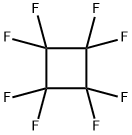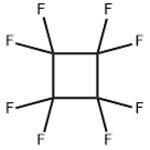Octafluorocyclobutane is a colorless gas.Molecular weight = 200.03; Boiling point = -6℃;Freezing/Melting point = -41℃. Hazard Identification(based on NFPA-704 M Rating System): Health 2,Flammability 0, Reactivity 0. Slightly soluble (slighthydrolysis).
Octafluorocyclobutane is a colorless liquefied gas with an ethereal odor. Poor warning properties at low concentrations. Asphyxiant in high concentrations. Gas density is heavier than air. Octafluorocyclobutane is an etching agent.
Refrigerant; heat-transfer medium.
Halocarbon 318 is used for plasma etching. When it is exposed to the RF field generated in the etching process, a gas plasma is produced that will etch silicon compounds with excellent selectivity.
ChEBI: A fluorocarbon that is cyclobutane in which all eight hydrogens are replaced by fluorines.
Octafluorocyclobutane is a colorless nonflammable gas. Octafluorocyclobutane may be harmful by asphyxiation. Exposure of the container to prolonged heat or fire can cause Octafluorocyclobutane to rupture violently and rocket. Octafluorocyclobutane is used to make other chemicals.
Octafluorocyclobutane is chemically inert in many situations, but can react violently with strong reducing agents such as the very active metals and the active metals. They suffer oxidation with strong oxidizing agents and under extremes of temperature.
Vapors may cause dizziness or asphyxiation without warning. Vapors from liquefied gas are initially heavier than air and spread along ground. Contact with gas or liquefied gas may cause burns, severe injury and/or frostbite. Fire may produce irritating, corrosive and/or toxic gases.
Some may burn but none ignite readily. Containers may explode when heated. Ruptured cylinders may rocket.
Mdly toxic by
ingestion and inhalation. Can cause slight
transient effects at high concentrations. No
anesthesia or central nervous system effects.
Nonflammable gas. Mutation data reported.
When heated to decomposition it emits
hghly toxic fumes of F-.
This material is used as a refrigerant.
If this chemical gets into the eyes, remove anycontact lenses at once and irrigate immediately for at least15 min, occasionally lifting upper and lower lids. Seek medical attention immediately. If this chemical contacts theskin, remove contaminated clothing and wash immediatelywith soap and water. Seek medical attention immediately. If this chemical has been inhaled, remove from exposure,begin rescue breathing (using universal precautions, including resuscitation mask) if breathing has stopped and CPR ifheart action has stopped. Transfer promptly to a medicalfacility. When this chemical has been swallowed, getmedical attention. Give large quantities of water and inducevomiting. Do not make an unconscious person vomit.Medical observation is recommended for 24-48 h afterbreathing overexposure, as pulmonary edema may bedelayed. As first aid for pulmonary edema, a doctor orauthorized paramedic may consider administering a corticosteroid spray.
Color Code—Green: General storage may be used.Prior to working with this chemical you should be trainedon its proper handling and storage. Store in tightly closedcontainers in a cool, well-ventilated area away from potential high heat sources. Protect cylinders from physical damage. Procedures for the handling, use, and storage ofcylinders should be in compliance with OSHA 1910.101and 1910.169, as with the recommendations of theCompressed Gas Association.
UN1976 octafluorocyclobutane, or refrigerant
gas RC-318, Hazard class: 2.2; Labels: 2.2-Nonflammable
compressed gas. Cylinders must be transported in a secure
upright position, in a well-ventilated truck. Protect cylinder
and labels from physical damage. The owner of the compressed
gas cylinder is the only entity allowed by federal
law (49CFR) to transport and refill them. It is a violation
of transportation regulations to refill compressed gas cylinders
without the express written permission of the owner.
Purify octafluorocyclobutane by trap-to-trap distillation, retaining the middle portion. [Danus Ind Eng Chem 47 144 1955, Claasen J Chem Phys 18 543 1950, Beilstein 5 III 8, 5 IV 8.]
Octafluorocyclobutane is chemically inert
in many situations, but can react violently with strong reducing
agents such as hydrides and the active metals and especially
the very active metals. They suffer oxidation with strong oxidizing
agents and under extremes of temperature.
Return refillable compressed
gas cylinders to supplier. Nonrefillable cylinders should be
disposed of in accordance with local, state and federal regulations.
Allow remaining gas to vent slowly into atmosphere
in an unconfined area or exhaust hood. Refillabletype
cylinders should be returned to original supplier with
any valve caps and outlet plugs secured and valve protection
caps in place.



